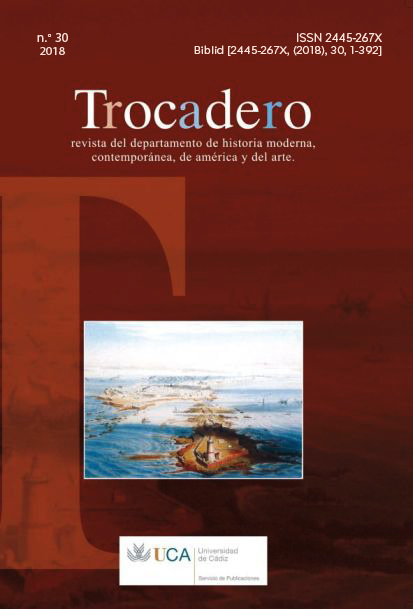The Invisibilization of Women in the Studies of Migratory Processes

DOI
https://doi.org/10.25267/Trocadero.2018.i30.06Info
Abstract
This article aims to explain the exclusion of women as active subjects in the studies of their migratory movements, as well as to explain the specific factors forcing them to migrate. This is particularly important since the main theories on migratory movements lack the perspective of women as active subjects. Firstly, we will describe the reasons why women have not been integrated as active subjects in these studies; and, secondly, we will analyze the consequences of this omission. We will finish the present work with an example of how the introduction of the perspective of gender in the study of one of the current reasons of women’s migrations, specifically sexual violence in the armed conflicts improves the results of these studies and allows the public policies to know and to eradicate these reasons of migration.
Keywords
Downloads
How to Cite
License
Authors who publish in this journal agree to the following conditions:
- The authors retain copyright and grant the journal the right of first publication, allowing third parties to use the published work as long as they mention the authorship and first publication in this journal.
- Authors may subscribe to other independent and additional contractual arrangements for non-exclusive distribution of the version of the article published in this journal (e.g., inclusion in an institutional repository or publication in a book) as long as they clearly indicate that the work was first published in this journal.
The terms of the licence can be found at the following link:
https://creativecommons.org/licenses/by-nc-nd/4.0/

References
GÓMEZ WALTEROS, Jaime Alberto: “La migración internacional: teorías y enfoques, una mirada actual”. Revista Semestre Económico, vol. 13, nº. 26 (2010), pp. 81-99.
ARANGO, Joaquín: “Enfoques conceptuales y teóricos para explicar la migración”. Revista Internacional de Ciencias Sociales, nº. 165 (2000), pp. 45-46.
CARRETERO PALACIOS, Amparo: “Migraciones y género. La feminización de la migración transnacional” Forinter2: Formación en Interculturalidad y Migraciones. Consejería de Exterior. Junta de Andalucía.
https://www.juntadeandalucia.es/export/drupaljda/migraciones_genero.pdf (Consultado en noviembre 2018).
DE LA CRUZ, Carmen: “Guía metodológica para integrar la perspectiva de género en proyectos y programas de desarrollo”, Emakunde-Instituto Vasco de la Mujer, Vitoria-Gasteiz, 1999.
Organización Internacional para las Migraciones. Migración y género sección 2.10. Fundamentos de Gestión de la Migración. Volumen Dos: Desarrollo de Políticas sobre Migración.
https://es-static.z-dn.net/files/d57/93556184763e0778668ffc3ff7f7f953.pdf (Consultado en noviembre 2018).
CASADO FRANCISCO, Montserrat; MOLINA SÁNCHEZ, Luis; OYARZUN DE LA IGLESIA, Javier: “El análisis económico de los movimientos migratorios internacionales: nuevas propuestas de regulación”. Investigación Económica, vol. 65, nº. 257 (2006), pp. 181-210.
“THE IRC Commission on Syrian Refugees” The International Rescue Committee: Rescue.org. Marzo 2012. Revista on line:
www.rescue.org/sites/default/files/resource-file/IRCReportMidEast20130114.pdf (Consultado en noviembre 2018).
No debemos olvidar que en el uso de la violencia sexual en los conflictos armados tanto hombres como mujeres son víctimas de estas violaciones.
IBÁÑEZ, Ruth L.: “La violencia sexual contra la población femenina, un arma de guerra en Siria”
http://www.unitedexplanations.org/2014/12/08/la-violencia-sexual-contra-la-poblacion-femenina-un-arma-de-guerra-en-siria/# (Consultado en noviembre 2018).
VILLELLAS ARIÑO, María: “La violencia sexual como arma de guerra”. Quaderns De Construcció De Pau nº 15 (2010),
http://escolapau.uab.cat/index.php?option=com_content&view=article&id=49&Itemid=73〈=es (Consultado en noviembre 2018).
Resolución 1325 del Consejo de Seguridad De Las Naciones Unidas:
http://www.un.org/ga/search/view_doc.asp?symbol=S/RES/1325%282000%29&referer=/english/&Lang=S (Consultado en noviembre 2018).






